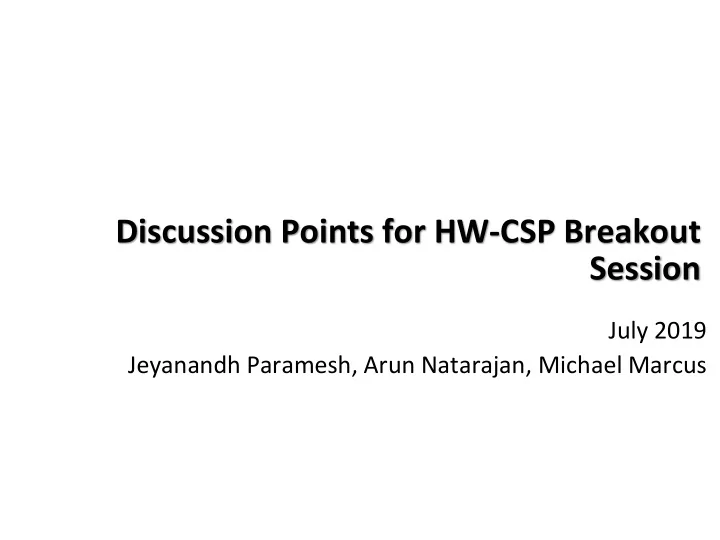

Discussion Points for HW-CSP Breakout Session July 2019 Jeyanandh Paramesh, Arun Natarajan, Michael Marcus
Jeyanadh Paramesh - CMU Slide 2
System Issues ▪ Massive MIMO ❖ Extremely high hardware complexity → how many elements? ❖ Where to use → Backhaul? Uplink? Downlink? Or all? ❖ How many elements? At base-station, At mobile? ▪ MIMO approaches ❖ Will digital beamforming be viable? If so, in what scenarios? ❖ Is hybrid beamforming the answer? What are the big issues? How to scale? ❖ Beamspace MIMO? ▪ Scalable energy models for massive MIMO radios? ▪ What role can machine learning play? Slide 3
Signal Processing & Algorithms ▪ Lots of current research on new algorithms for mm-wave communication systems ❖ Channel estimation, beam acquisition and tracking, precoding and (de)modulation, training, equalization etc. ▪ Are their underlying assumptions valid? ❖ Modeling of hardware structures and imperfections ❖ Sparsity of channel models ▪ What is the energy footprint of these algorithms? ❖ Compressive algorithms? ❖ Basestation vs mobile ▪ How should we intelligently partition the signal processing across RF, analog and digital domains? ▪ Can Cloud-RAN address energy challenges at basestation/network level? ▪ Energy costs of error-correcting codes? Slide 4
Chip-level Challenges ▪ Transmitter (i.e., PA’s at back -off) ❖ What is transmitter power consumption in hybrid MIMO? ❖ All-CMOS vs (III-V + CMOS) transmitter? ▪ Designing for ultra-wide mm-wave frequency ranges ▪ Frequency synthesis and LO distribution → phase-noise & spurs ▪ ADC’s and DAC’s ▪ Digital power consumption ▪ What co-existence and interference issues to consider? ❖ Communication with radar? Slide 5
Packaging & Non-chip Challenges ▪ Packaging issues ▪ Antenna design ❖ Reconfigurable? ❖ Multi-band? ▪ What about non-electronic RF-domain beam-steering? ❖ Mechanical beamforming, lens-based beamforming, beamspace MIMO ▪ Testing challenges at various levels? ❖ Chip, module, benchtop, on-air Slide 6
HW/CSP Issues in Future Systems ▪ What approaches to increase spectral efficiency and network capacity? ❖ Spatial multiplexing ❖ Cognitive sensing ❖ Polarization MIMO ❖ Full-duplex ▪ Physical layer security ❖ Using directionality, power control, encryption? ▪ Combined sensing (radar/imaging) + comms @ mm-wave Slide 7
Electromagnetics (antennas/array design) Communication theory RF/Analog IC Networking Design Signal processing Digital IC Design or FPGA Implementation Slide 8
Critical challenges: • Emerging Phased Array and MIMO links correspond to signals with high PAPR – PA back-off efficiency is a critical challenge. How to make per-element digitization a reality? • Packaging at mm-wave is expensive: as systems evolve from 28GHz to >40GHz to beyond 60GHz, achieving dense element spacing with multiple IO is challenging • Testing arrays with hundreds of elements • MIMO architectures require synchronization per element – LO is power-hungry • How to build antennas and ICs to address multiple bands. Oregon State High-Speed Integrated Circuits Group
Cramming More Radios: Wave-length Scale Integrated Circuits Associate Professor, School of EECS, Oregon State University, Corvallis, OR nataraja@oregonstate.edu 2
Cramming More Components onto Integrated Circuits The last paragraph of Gordon Moore’s seminal paper in 1965: “Even in the microwave area, structures included in the definition of integrated electronics will become increasingly important. … The successful realization of such items as phased-array antennas, for example, using a multiplicity of integrated microwave power sources, could completely revolutionize radar .” 3 Oregon State High-Speed Integrated Circuits Group
Silicon Arrays: The first 15 years • Master/Slave ICs with partition of array and frequency translation functions. • Arrays with > 100 elements demonstrated, however few beam outputs. • Complex packages with mm-wave impedance-controlled signal routing. 4 Oregon State High-Speed Integrated Circuits Group
Scalable RF/mmWave MIMO Arrays 5 Oregon State High-Speed Integrated Circuits Group
Wavelength-Scale Integrated Circuits at mm-Wave • Novel array approaches possible with co-design of EM interfaces and mm-wave IC 6 Oregon State High-Speed Integrated Circuits Group
Silicon Arrays: The next 10 years? 300 250 Number of Elements 200 150 100 50 0 Year 2004 2009 2014 2019 Challenges: • Antenna-IC co-integration and meeting l /2 x l /2 fill factor. • Transmitter array efficiency under modulation. • Receiver linearity and dynamic range. • LO and IF interfaces and resultant package complexity. 7 Oregon State High-Speed Integrated Circuits Group
Wafer-scale Antenna Co-integration for Simplified Packaging • Wafer-scale compatible, efficient and simple antenna interface. • Antenna approach accommodates metal-fill rules in CMOS, eliminates mm-wave IO to/from IC. • Antenna co-design enables optimization of antenna interface, antenna power combining. 8 Oregon State High-Speed Integrated Circuits Group
MIMO Single-wire Interface Scheme Single-wire Interface multiplexes IF I and Q signals from multiple elements using frequency/code-domain multiplexing to enable Digital Beamforming 9 Oregon State High-Speed Integrated Circuits Group
Antenna Issues Michael Marcus Virginia Tech
The key challenges Massive spatial multiplexing: computational complexity, dynamic range Ultra-high-resolution imaging systems standard arrays: # pixels = # RF channels need reduced-complexity imaging: #pixels >> # RF channels many established techniques Packaging Some systems need l /2 element spacing: hard to make it fit. high-frequency parasitics Spectral allocation gaining FCC access to useful frequency bands
It It is unusual to see both mmWave and spectrum policy on network TV!
Current 24 GHz controversy shows spectrum policy issues can impact new technology For more see: https://www.google.com/search?q=fcc+nasa+weather+24+ghz
mmW Spectrum realities • Compared to lower spectrum a high density of passive allocations, due to molecular resonances, fragments spectrum • Implicit result: contiguous bandwidths >26 GHz impossible unless antenna technology is found to control high elevation angle eirp in passive bands • Ongoing 24 GHz 5G/NASA/NOAA weather satellite controversy is a close relative of this problem • Enter “FCC 5G weather” in your favorite search engine & you’ll see!
In Interference Mechanisms Priebe et al. , IEEE Trans. THz, Sept., 2012
Possible Solutions Paths • MIMO variant that adjusts subantennas to both maximize power transfer from transmitter to receiver and place a null on (Az,El) of passive satellite with known orbit • Quasioptical antennas using lenses and absorbers to limit high elevation angle sidelobes much more than dishes & horns • Coherent/laser-like RF sources ---------------------------- • Antenna test ranges/measurement techniques also needed to confirm actual performance
Recommend
More recommend